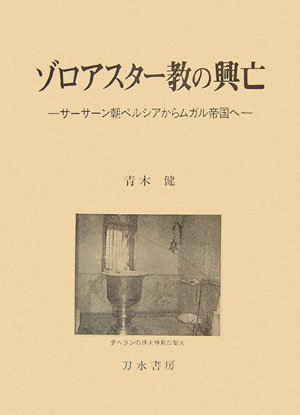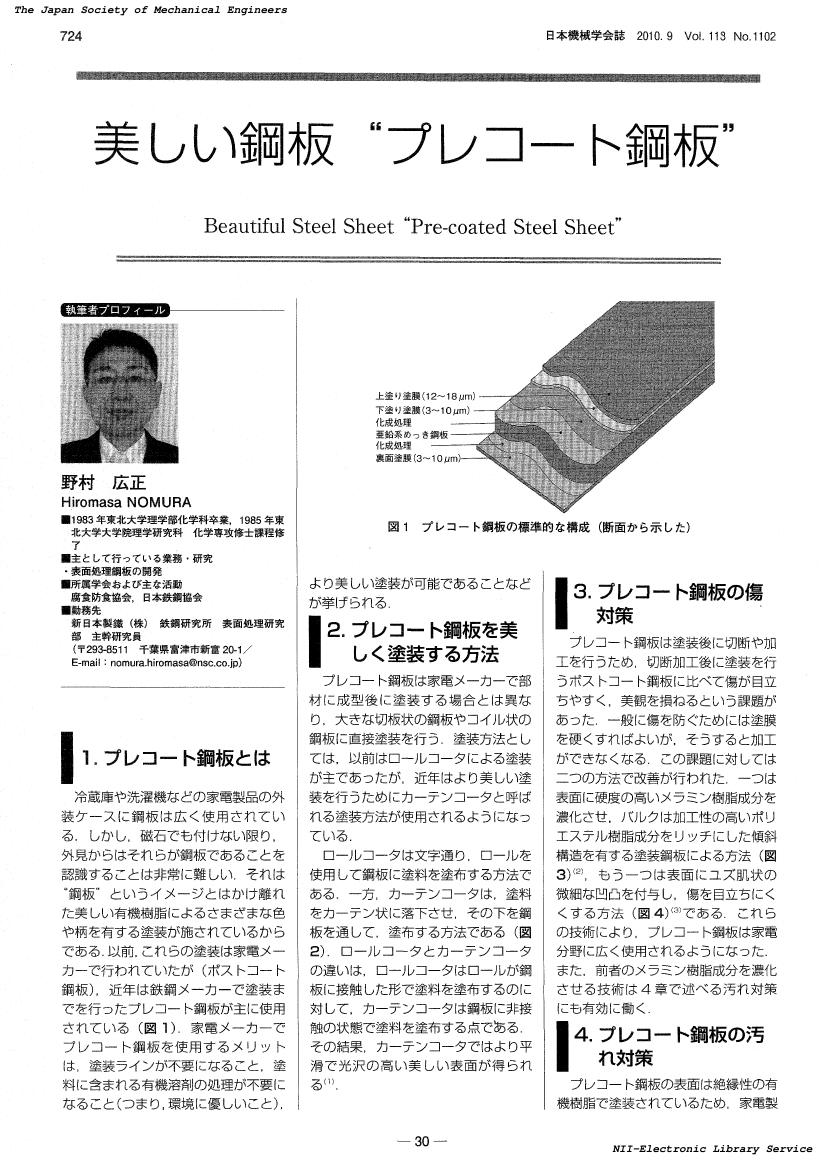1 0 0 0 IR H.v.シーボルト著『考古説略』と明治期の日本考古学
- 著者
- 平田 健
- 出版者
- 明治大学図書館
- 雑誌
- 図書の譜 (ISSN:1342808X)
- 巻号頁・発行日
- no.12, pp.139-156, 2008-03
1 0 0 0 IR クラチュロス主義の乗り越え--マラルメの『英単語』の場合
- 著者
- 立花 史
- 出版者
- 早稲田大学大学院文学研究科
- 雑誌
- 早稲田大学大学院文学研究科紀要. 第2分冊 (ISSN:13417525)
- 巻号頁・発行日
- vol.51, pp.127-138, 2005
1 0 0 0 テーマ・チタンの補綴応用にあたっての問題点と展望
- 著者
- 嶋倉 道郎
- 出版者
- 社団法人 日本補綴歯科学会
- 雑誌
- 日本補綴歯科學會雜誌 = The journal of the Japan Prosthodontic Society (ISSN:03895386)
- 巻号頁・発行日
- vol.42, no.4, 1998-08-10
- 被引用文献数
- 1
1 0 0 0 IR 「カザク・ハン国」形成史の再考:ジョチ・ウルス左翼から「カザク・ハン国」へ
- 著者
- 長峰 博之
- 出版者
- 東洋文庫
- 雑誌
- 東洋学報 = The Toyo Gakuho (ISSN:03869067)
- 巻号頁・発行日
- vol.90, no.4, pp.441-466, 2009-03
The so-called "Qazaq khanate" was founded around the late 15th century by Jani Beg and Giray, who claimed descent from Oros of the left hand of the ulūs-i Jūchī. The foundation of the "Qazaq khanate" has been the subject of animated discussion, which, unfortunately, has been marred by a historical view about the ethnic origins of the present "Kazakh nation." The aims of this article are 1) to reconstruct the historical record from the time of the left hand of the ulūs-i Jūchī to the foundation of the "Qazaq khanate," based mainly on Qädir 'Alī Beg's Jāmi' al-Tawārīkh written at the beginning of the 17th century as a historical account of the successive polities of the ulūs-i Jūchī, and 2) to reconsider the foundation of the "Qazaq khanate" in relation to the disintegration and reorganization of the ulūs-i Jūchī. The left hand of the ulūs-i Jūchī was revived by Oros of the Tuqa Timurids in its disintegration and reorganization of whole ulūs-i Jūchī, which began in the late 14th century, and proceeded to dominate the eastern Dasht-i Qipchāq again during the lime of Baraq in the early 15th century. Although it is said that the "Qazaq khanate" was founded as a new polity during the time of Jani Beg and Giray in the late 15th century, it was actually a nomadic polity which succeeded to the left hand of the ulūs-i Jūchī revived by Oros. According to the sources, Jani Beg and Giray acted like "卯z匈"s in lheir rivalrieswith the Shibanids, and therelbre came to be caUed "卯z向."However,lhedescriptions in "漏削j'α/-712waj・疏ゐ"and other sources reveal that they werehistorically idenlified as the Orosids who succeeded to the left hand of lheu珀s-j jziai, rather than as "卯z向"s, and thus within the Juchids. Theref1〕re,the "Qazaq khanate" should be considered as a nomadic polity with orosidstaking over the len hand of the las-j jzicゐi at its core, in the process of lhedisintegrationand reorganization of the zl/iis-iJicM.
1 0 0 0 OA 「カザク・ハン国」形成史の再考:ジョチ・ウルス左翼から「カザク・ハン国」へ
- 著者
- 長峰 博之
- 出版者
- 東洋文庫
- 雑誌
- 東洋学報 = The Toyo Gakuho (ISSN:03869067)
- 巻号頁・発行日
- vol.90, no.4, pp.441-466, 2009-03
The so-called “Qazaq khanate” was founded around the late 15th century by Jani Beg and Giray, who claimed descent from Oros of the left hand of the ulūs-i Jūchī. The foundation of the “Qazaq khanate” has been the subject of animated discussion, which, unfortunately, has been marred by a historical view about the ethnic origins of the present “Kazakh nation.” The aims of this article are 1) to reconstruct the historical record from the time of the left hand of the ulūs-i Jūchī to the foundation of the “Qazaq khanate,” based mainly on Qädir ‘Alī Beg’s Jāmi‘ al-Tawārīkh written at the beginning of the 17th century as a historical account of the successive polities of the ulūs-i Jūchī, and 2) to reconsider the foundation of the “Qazaq khanate” in relation to the disintegration and reorganization of the ulūs-i Jūchī. The left hand of the ulūs-i Jūchī was revived by Oros of the Tuqa Timurids in its disintegration and reorganization of whole ulūs-i Jūchī, which began in the late 14th century, and proceeded to dominate the eastern Dasht-i Qipchāq again during the lime of Baraq in the early 15th century. Although it is said that the “Qazaq khanate” was founded as a new polity during the time of Jani Beg and Giray in the late 15th century, it was actually a nomadic polity which succeeded to the left hand of the ulūs-i Jūchī revived by Oros. According to the sources, Jani Beg and Giray acted like “卯z匈”s in lheir rivalrieswith the Shibanids, and therelbre came to be caUed “卯z向.”However,lhedescriptions in “漏削j‘α/-712waj・疏ゐ”and other sources reveal that they werehistorically idenlified as the Orosids who succeeded to the left hand of lheu珀s-j jziai, rather than as “卯z向”s, and thus within the Juchids. Theref1〕re,the “Qazaq khanate” should be considered as a nomadic polity with orosidstaking over the len hand of the las-j jzicゐi at its core, in the process of lhedisintegrationand reorganization of the zl/iis-iJicM.
1 0 0 0 ゾロアスター教の興亡 : サーサーン朝ペルシアからムガル帝国へ
- 著者
- 青木 健
- 出版者
- 日本宗教学会
- 雑誌
- 宗教研究 (ISSN:03873293)
- 巻号頁・発行日
- vol.81, no.3, pp.653-674, 2007
ゾロアスター教研究の資料には、六-一〇世紀に執筆された内部資料であるパフラヴィー語文献と、その他の言語による外部資料がある。外部資料の研究としては、ギリシア語・ラテン語、シリア語、アルメニア語、漢文、近世ヨーロッパ諸語などの資料ごとに纏まったコーパスがあるものの、アラビア語資料を用いた本格的な研究は依然としてなされていない。本論文は、アラビア語資料を完全に網羅した訳ではないが、ある程度の資料に当たって、アラビア語資料によるゾロアスター教研究の方向性を示した試論である。暫定的な結論として、サーサーン王朝時代のペルシア帝国領内のゾロアスター教は一枚岩ではなく、各地方ごとのゾロアスター教が存在したこと、パフラヴィー語文献は、そのうちのイラン高原南部のゾロアスター教を代表するに過ぎないこと、メソポタミアやイラン高原東部のゾロアスター教の実態は、却ってアラビア語資料から類推できることが判明した。
1 0 0 0 OA セバスティアン・カステリヨン『疑うすべについて』(第2巻;抄訳)
- 著者
- 小山 誠南
- 出版者
- 北海道大学大学院教育学研究院
- 雑誌
- 北海道大学大学院教育学研究院紀要 (ISSN:18821669)
- 巻号頁・発行日
- vol.138, pp.275-291, 2021-06-25
本稿はSébastien Castellion, De l'art de douter et de croire, d'ignorer et de savoir(traduit du latin par Charles Baudouin, éd. Jeheber, Genève-Paris, 1953)の改訂版(réédition Carrière-sous-Poissy, Éditions La Cause, 1996)の125頁から144頁を翻訳したものである。なお翻訳にあたっては,E. F. ヒルシュによる本書のラテン語原文の校訂版,Castellio, S., De arte dubitandi et confidendi, ignorandi et sciendi(Leiden, E. J. Brill, 1981)も参照し,鍵となる語彙についてはラテン語を付記した。 今回訳出したのは第2巻の冒頭,第1章から第6章である。ここではカステリヨンの持つ三位一体論と信仰論が展開されており,彼の思想を知る上で非常に興味深い議論がなされている。なお【翻訳】における注記は全て原注に従っている。
1 0 0 0 十七文字
- 著者
- Yamamoto Hisae 小林 富久子
- 出版者
- みすず書房
- 雑誌
- みすず
- 巻号頁・発行日
- vol.41, no.12, pp.2-14, 1999-12
1 0 0 0 IR 「国旗」と"the Flag"--太平洋戦争中の日系アメリカ俳句
- 著者
- 荒木 純子
- 出版者
- 東京大学大学院総合文化研究科附属アメリカ太平洋地域研究センター
- 雑誌
- アメリカ太平洋研究 (ISSN:13462989)
- 巻号頁・発行日
- vol.2, pp.227-239, 2002-03
application/pdf
1 0 0 0 OA 美しい鋼板"プレコート鋼板"(<メカライフ特集>綺麗にする)
- 著者
- 野村 広正
- 出版者
- 一般社団法人 日本機械学会
- 雑誌
- 日本機械学会誌 (ISSN:24242675)
- 巻号頁・発行日
- vol.113, no.1102, pp.724-725, 2010-09-05 (Released:2017-06-21)
- 参考文献数
- 5
1 0 0 0 IR ゲーミフィケーションを用いた租税授業の開発 : 「目指せ!パーフェクト納税者」の実践から
- 著者
- 中村 綾李
- 出版者
- 千葉大学大学院人文公共学府
- 雑誌
- 千葉大学大学院人文公共学府研究プロジェクト報告書 = Chiba University Graduate School of Humanities and Study of Public Affairs Research Project Reports (ISSN:18817165)
- 巻号頁・発行日
- no.324, pp.33-40, 2018-02-28
[要旨] 税金は、国民生活や経済社会と密接に関係するものであり私たちの暮らしを大きく支えている。また、様々な公共サービスを提供する活動の財源にもなっており、税制度は国民にとって大切なものである。次世代を担う子どもたちが、税金について正しい知識と理解を持ち、国の在り方を納税者として考えることをできるようにすることが必要である。租税教育の充実に向け、学校だけではなく多くの団体が租税教育事業に取り組んでいるが課題もある。中学校社会科の授業における租税教育では、学習指導要領の内容を子どもたちが十分に理解をし、納税者としての自覚を持てるような授業がなされていないのではないだろうか。本稿は、納税と生活における行動との繋がりを題材とした、ゲーミフィケーションの考えを用いた「目指せ!パーフェクト納税者」という教材を作成し、租税教育における教材としての有効性と課題について明らかにした。
1 0 0 0 OA 門地二品について
- 著者
- 川合 安
- 出版者
- 中国文史哲研究会
- 雑誌
- 集刊東洋学 = SHUKAN TOYO GAKU (CHINESE and ORIENTAL STUDIES) (ISSN:04959930)
- 巻号頁・発行日
- vol.94, pp.41-62, 2005-10-31
- 著者
- 山中 義崇
- 出版者
- 日本神経治療学会
- 雑誌
- 神経治療学 (ISSN:09168443)
- 巻号頁・発行日
- vol.37, no.6, pp.S169, 2020 (Released:2020-10-05)
- 著者
- 福本 淳文 山内 利宏
- 雑誌
- 情報処理学会論文誌 (ISSN:18827764)
- 巻号頁・発行日
- vol.61, no.9, pp.1507-1518, 2020-09-15
権限昇格攻撃はシステムの改ざんや情報漏えいにつながる可能性がある.これに対処するために,我々はシステムコールによる権限の変更に着目した権限昇格攻撃防止手法(以降,先行研究の手法)を提案した.しかし,先行研究の手法はOS内で実現されており,導入するために,カーネルソースコードを変更する必要がある.また,先行研究の手法では,変更の検証のために保存したカーネル空間内の権限情報を,攻撃者に改ざんされる可能性がある.本論文では,これらの課題に対処するために,仮想マシンモニタであるKVMを用いて権限昇格攻撃を防止する手法を提案する.提案手法は,ゲストOS上のシステムコール発行をフックし,システムコール処理による権限の変更を検証する.提案手法の実現により,手法の導入にともなうカーネルソースコードの変更が不要となる.また,権限情報をホストOSのメモリ領域に保存することで,権限情報の改ざんが困難となる.本論文では,先行研究の手法の課題を示し,提案手法や評価の結果について述べる.
1 0 0 0 OA 戦時期朝鮮における人絹紡績業と人絹織物業
- 著者
- 福岡 正章
- 出版者
- 一般財団法人 アジア政経学会
- 雑誌
- アジア研究 (ISSN:00449237)
- 巻号頁・発行日
- vol.50, no.3, pp.65-84, 2004 (Released:2014-09-15)
1 0 0 0 イオン液体を利用した革新的経皮デリバリー技術の開発
タンパクや核酸など高分子医薬品の低侵襲的投与法として経皮投与技術の開発が切望されている。最大のバリアである皮膚の角質層を突破させるため、透過促進剤やマイクロニードルの活用、超音波や電気などの物理的な刺激を利用する方法などが提案されてきた。しかし、高分子医薬品の透過に成功した報告は乏しく、実用化に進む可能性のある技術の開発は未達である。イオン液体は陽イオンと陰イオンからなる常温で液体の物質であり、その特徴的な性質から、新たな電池材料や溶剤としてなどグリーンケミストリーの素材として活用されてきている。しかし、医療応用に向けた試みは行われていない。本研究の目的は、イオン液体をキャリアとし、皮膚角質層の突破という最も大きな課題を一気に解決するための高分子医薬品の低侵襲的投与法を開発することである。本年度はモデル抗原としてインスリンを用い、in vitroでの皮膚透過性試験を行った。その結果、ある種のイオン液体と混合することで、インスリンの皮膚透過性が飛躍的に向上することが確認できた。次いでin vivoでの皮膚透過性試験を行った。その結果、インスリンが角質層を透過し、血中ににまで移行していることを血糖降下作用によって確認した。現在、がんペプチドであるWT1を用いて同様の検討を行っているが、同様に良好な結果が得られつつあり、当初の目的である画期的な低侵襲性の経皮型がんワクチンの開発に繋げていく予定である。
- 著者
- Toshihiro Iwai
- 出版者
- Springer
- 巻号頁・発行日
- 2021




